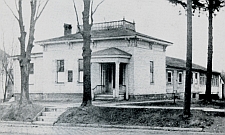In 1906, the First United Methodist Church of Pontiac grew too large for its building. In the interest of its members and the community, on January 22, 1907, Oakland Avenue Methodist Episcopal Church was founded. The original church consisted of 90 members and was housed in a home on Oakland Avenue. The grounds and home were remolded by the members themselves and served as the temporary Church home until 1910.
The Pontiac community was so successful and prosperous during that time that the church quickly became crowded and uncomfortable. In May of 1919, the crowded quarters led to the purchase of a tent, pitched on Federal property, and large enough to temporarily hold the growing congregation. Plans were soon underway for a great new church in the center of Pontiac.


“The tent cost $160 and was both comfortable and satisfactory, except when it blew down…” – The Pontiac Daily Press, October 31, 1932
In October of 1911, the cornerstone was laid for a new Pontiac Church on the corner of Huron and Perry streets in the center of the city (the current site of Pontiac Osteopathic Hospital,) prompting the name change to Central Methodist Episcopal Church.
In spite of tumultuous times, World War I and the post-war years brought a period of tremendous growth for the church that experienced an increase in membership to 1,319, making it the largest Protestant church in Oakland County at that time. By 1927, Central’s membership reached nearly 2,000 members. By 1957, the Church faced the difficult decision of extensive renovation and expansion, or moving. After much consideration, they chose to move three miles west of Pontiac along M-59 to their current Waterford location.
One of the more outstanding physical features of the current Church is the relief sculpture created for Central United Methodist Church by world-renowned artist, Marshall Fredericks. The sculpture, entitled “The Good Shepherd – The Child and the Lamb” is affixed to the front of the building and formed in gold anodized cast aluminum. The sculpture was commissioned especially for CUMC at a cost of $20,000 in 1964.

